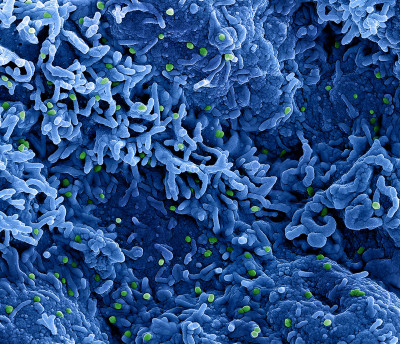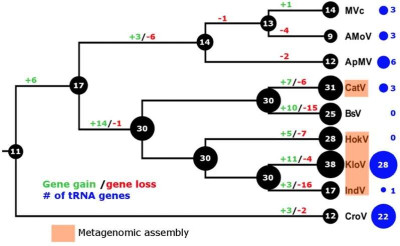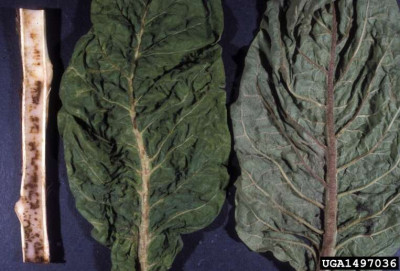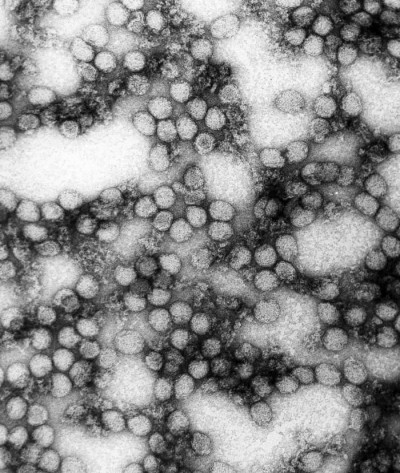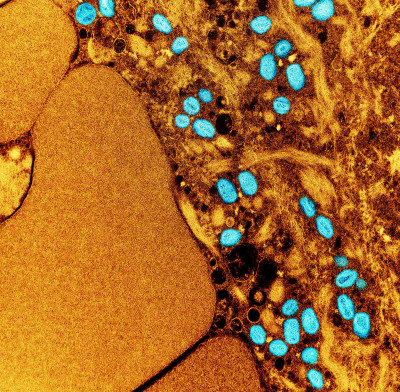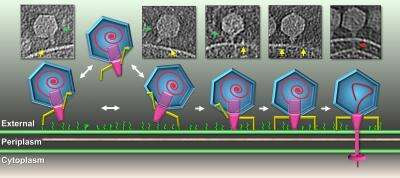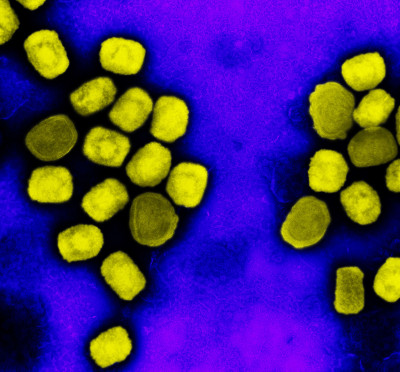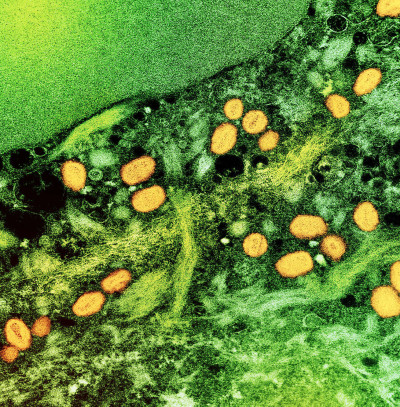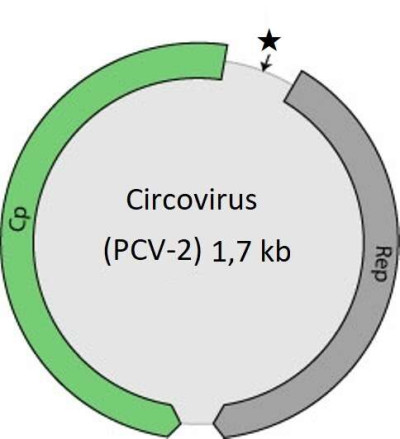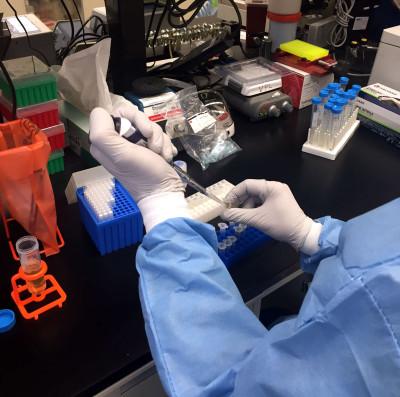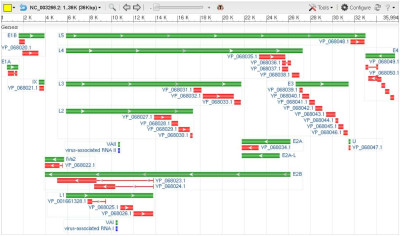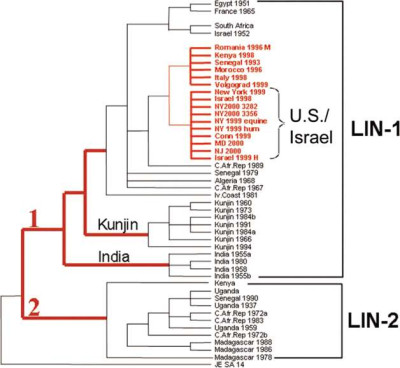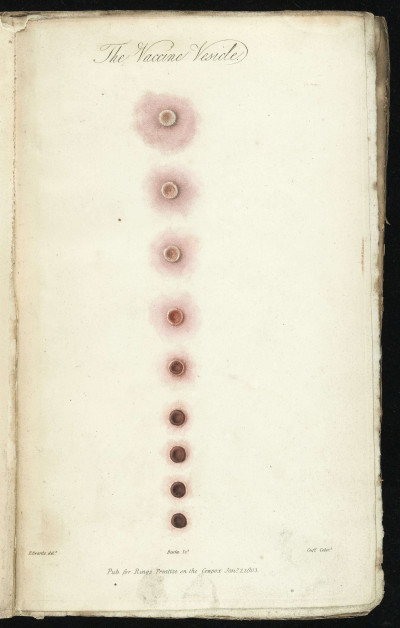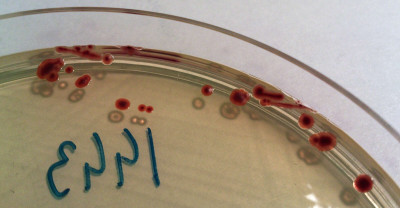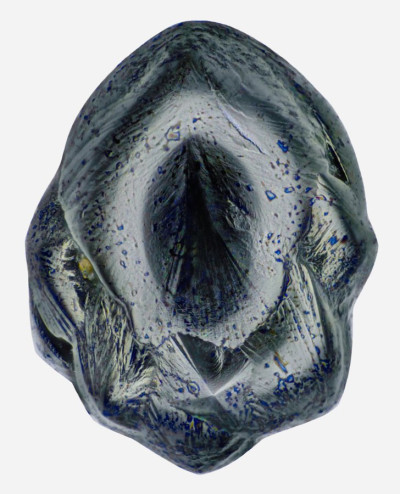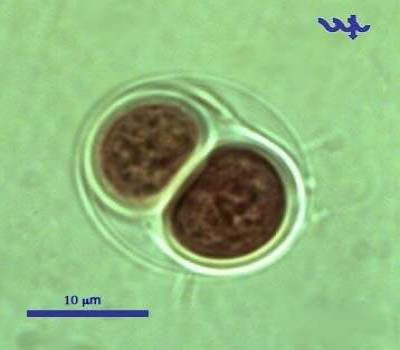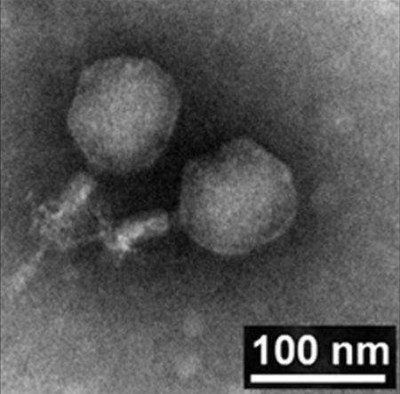Colorized scanning electron micrograph of monkeypox virus (green) on the surface of infected VERO E6 cells (blue). Image captured at the NIAID Integrated Research Facility (IRF) in Fort Detrick, Maryland.
Wikimedia Commons, NIAID
09 Apr 2024
Evolutionary history of translational machinery found in giant viruses inferred by COUNT. The size of the black circles mapped on a cladogram of the large members of the Mimiviridae represents the number of protein coding gene families involved in translation at each node or tip. Blue circles indicate the number of tRNA genes found in each genome. Gene gain and loss events are depicted along the branches. Genomes based on metagenomic assemblies are highlighted to indicate the possibility of incomplete representation of the translation machinery. MVc: Megavirus chilensis, AMoV: Acanthamoeba polyphaga Moumouvirus, ApMV: Acanthamoeba polyphaga Mimivirus, CatV: Catovirus, BsV: Bodo saltans virus, HokV: Hokovirus, KloV: Klosneuvirus (KlosnV), IndV: Indivirus, CroV: Cafeteria roenbergensis virus. [1]
Wikimedia Commons, Christoph M. Deeg, Cheryl-Emiliane T. Chow, Curtis A. Suttle
02 Apr 2024
Symptoms of potato virus Y (PVY) (potyvirus PVY) on tobacco.
Wikimedia Commons, University of Georgia Plant Pathology
14 Mar 2024
Genome map of the genus Luteovirus, family Tombusviridae (formerly in the now-defunct family Luteoviridae)
ViralZone, SIB Swiss Institute of Bioinformatics, Wikimedia Commons
15 Mar 2024
Yellow fever virus virions (234,000 X magnification).
CDC Public Health Image Library/ Erskine Palmer
02 Apr 2024
Colorized transmission electron micrograph of monkeypox particles (teal) found within an infected cell (brown), cultured in the laboratory. Image captured at the NIAID Integrated Research Facility (IRF) in Fort Detrick, Maryland.
Wikimedia Commons, NAID
08 Apr 2024
Tomograms of a T7 virion in action. The illustrations show T7 using its fibers to "walk" across the cell surface and infect the cell.
Wikimedia Commons, Hu et al.
08 Apr 2024
Colorized transmission electron micrograph of monkeypox virus particles (yellow) cultivated and purified from cell culture. Image captured at the NIAID Integrated Research Facility (IRF) in Fort Detrick, Maryland.
Wikimedia Commons, NAID
09 Apr 2024
Colorized transmission electron micrograph of monkeypox particles (yellow) found within an infected cell (green), cultured in the laboratory. Image captured at the NIAID Integrated Research Facility (IRF) in Fort Detrick, Maryland.
Wikimedia Commons, NAID
09 Apr 2024
Genome map of Porcine Circovirus 2 (PCV-2). Stern = Origin of replication (stem loop).
Wikimedia Commons, ViralZone, SIB Swiss Institute of Bioinformatics
18 Apr 2024
A Zika virus researcher at the NIAID Vaccine Research Center pipets samples.
Wikimedia Commons, NAID
24 Apr 2024
Human adenovirus E genome with transcription units shown as green bars, protein coding genes shown as red bars, and non-protein coding genes shown as blue bars.
Wikimedia Commons, National Library of Medicine
24 Apr 2024
Percentage of rotavirus tests with positive results, by surveillance week, United States, July 2000--June 2009.
Wikimedia Commons, U.S. Department of Health and Human Services
24 Apr 2024
Phylogenetic tree of West Nile viruses. [1]
Wikimedia Commons, Centers for Disease Control and Infection
10 May 2024
Description: Campylobacter jejuni colonies on CASA chromogenic medium, isolated from a canine stool sample. Date: 22 October 2014, 17:10:01.
Stefan Walkowski, Wikimedia Commons
26 Jul 2024
Diphtheriae (C.diphtheriae) the causative agent of diphtheria. If you use this image on your website/blog please give credit by linking to www.biology101.org.
Anthony D'Onofrio, Wikimedia Commons, www.biology101.org
08 Aug 2024
Under a microscope, a cosmic dust particle appears as a tiny, irregular fragment, often less than a few micrometers in size. These particles, originating from comets, asteroids, and even interstellar space, exhibit a complex structure, with surfaces that can be rough, smooth, or porous. Composed of silicates, carbon compounds, and metals, they may show intricate, crystalline formations or amorphous, glass-like textures. Some cosmic dust particles contain embedded nanometer-sized grains, which reflect their ancient origins. Despite their small size, these particles hold valuable information about the early solar system and the processes that shaped the universe.
09 Aug 2024
Chroococcus turgidus, (Cyanobacteria, Chroococales), from the pelagic waters of Lake Kinneret, April 2006, showing 2 daughter cells after division by simple binary fission – characteristic for most Chroococcales species. This species is common in the plankton of Lake Kinneret throughout the year. Usually, there are 2 to 8 cells in a colony. Clearly delimited colorless mucilaginous envelopes surround the individual cells, following their contours, and the entire colony. Cell diameter: 8 – 11 µm.
Alla Alster; Tamar Zohary, micro*scope
22 Jul 2024
TEM morphology of phage SH-Ab 15708.
Wikimedia Commons, Kenta Okamoto, Naoyuki Miyazaki, Hemanth K. N. Reddy, Max F. Hantke, Filipe R. N. C. Maia, Daniel S. D. Larsson, Chantal Abergel, Jean-Michel Claverie, Janos Hajdu, Kazuyoshi Murata, and Martin Svenda
10 Apr 2024
 Encyclopedia
Encyclopedia
